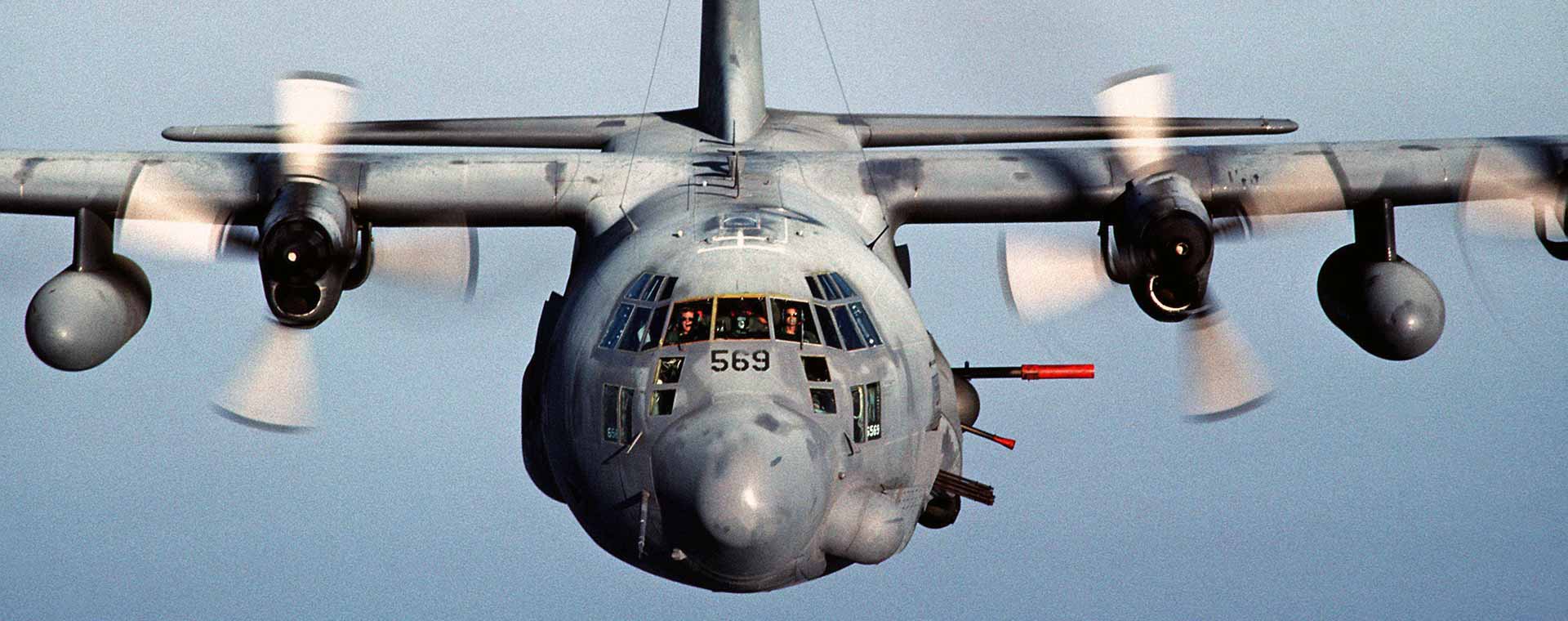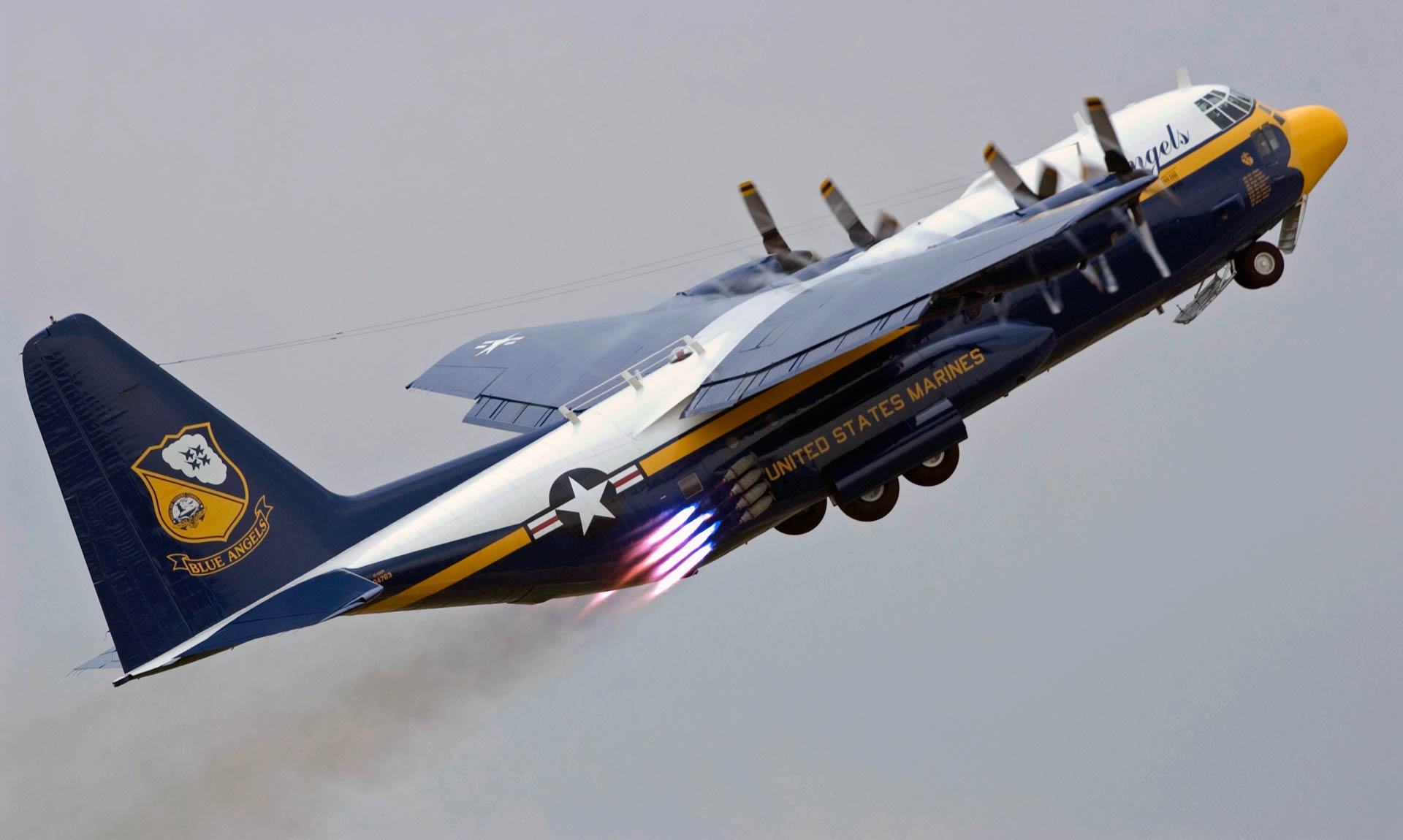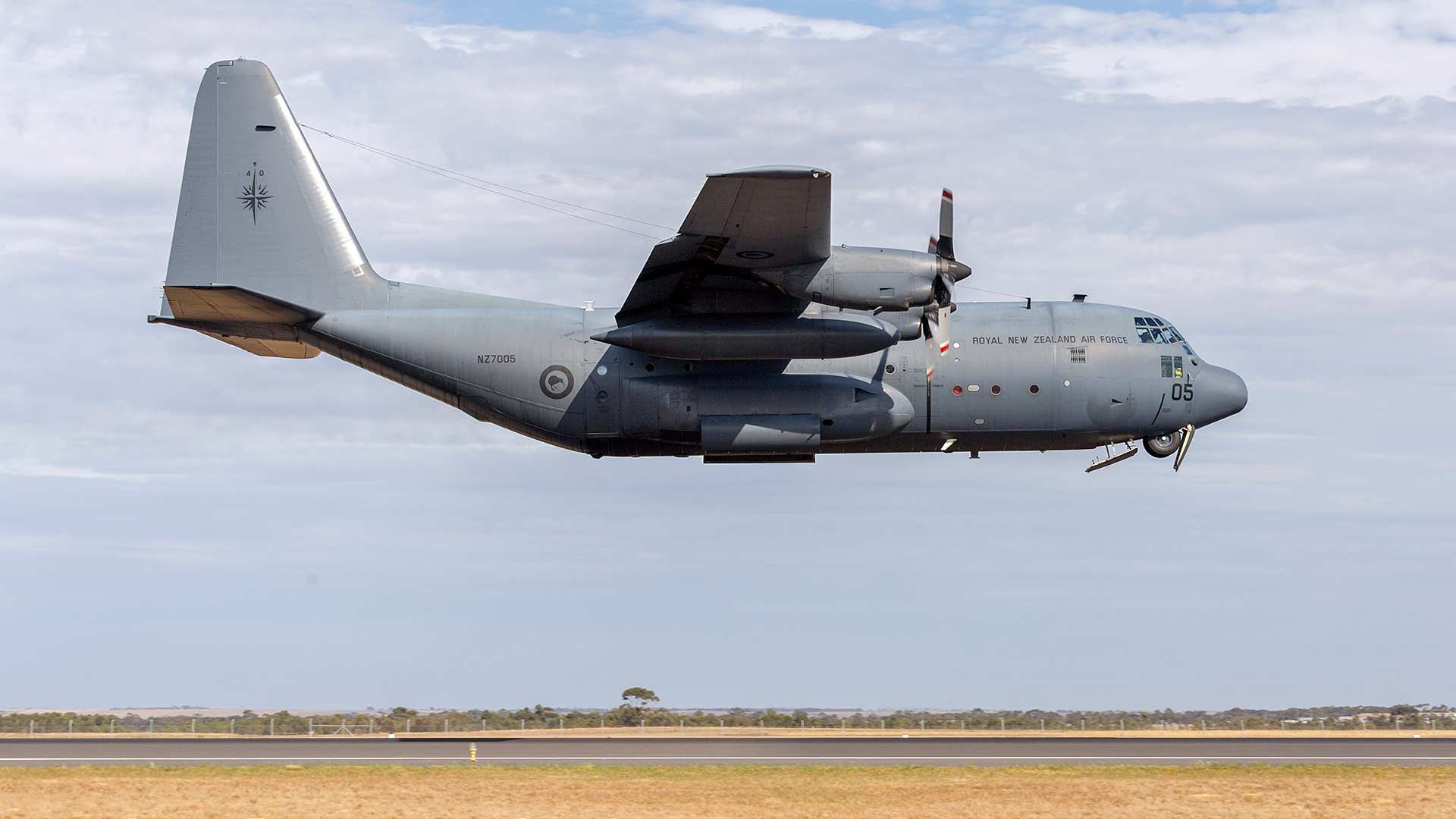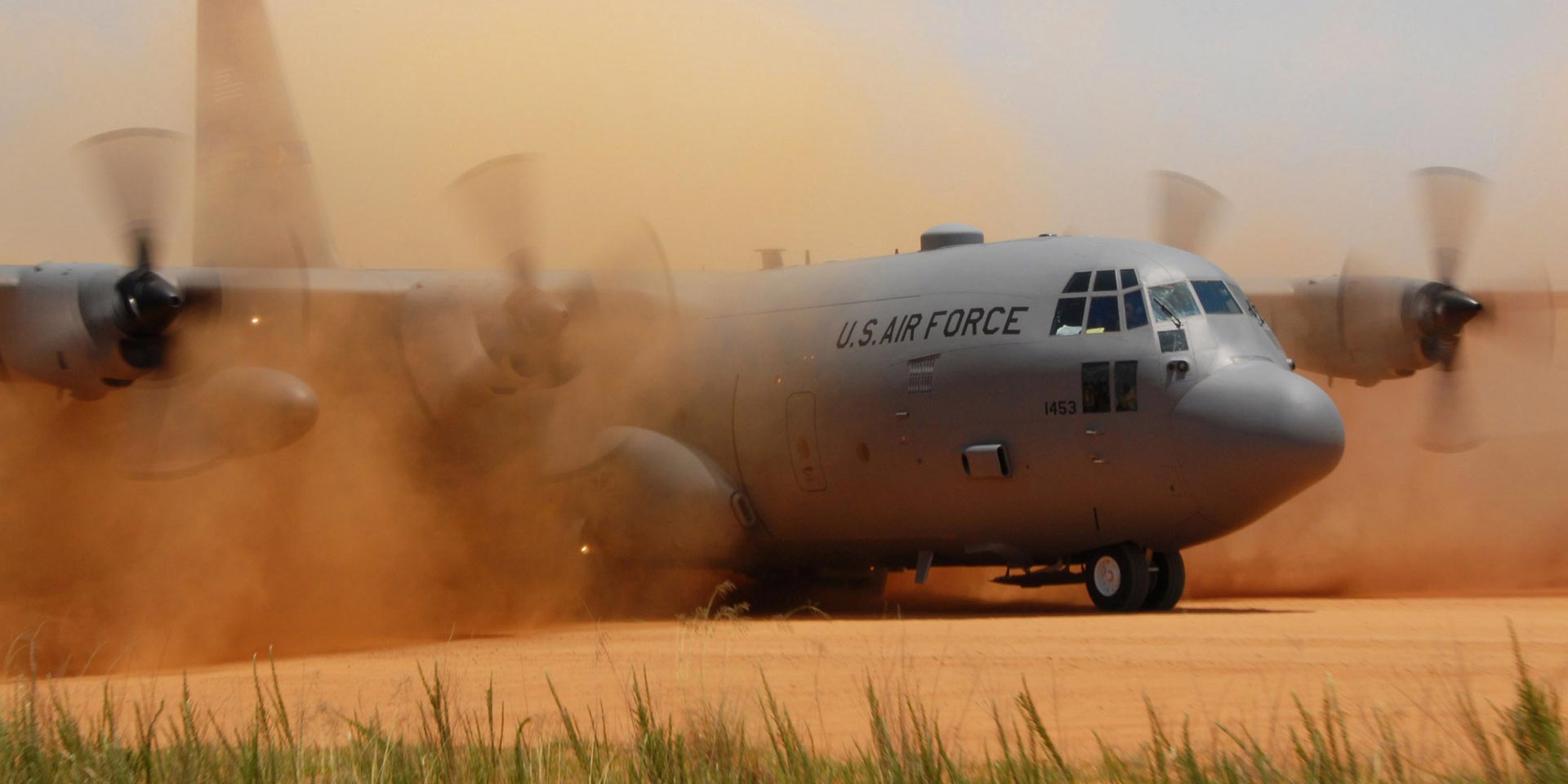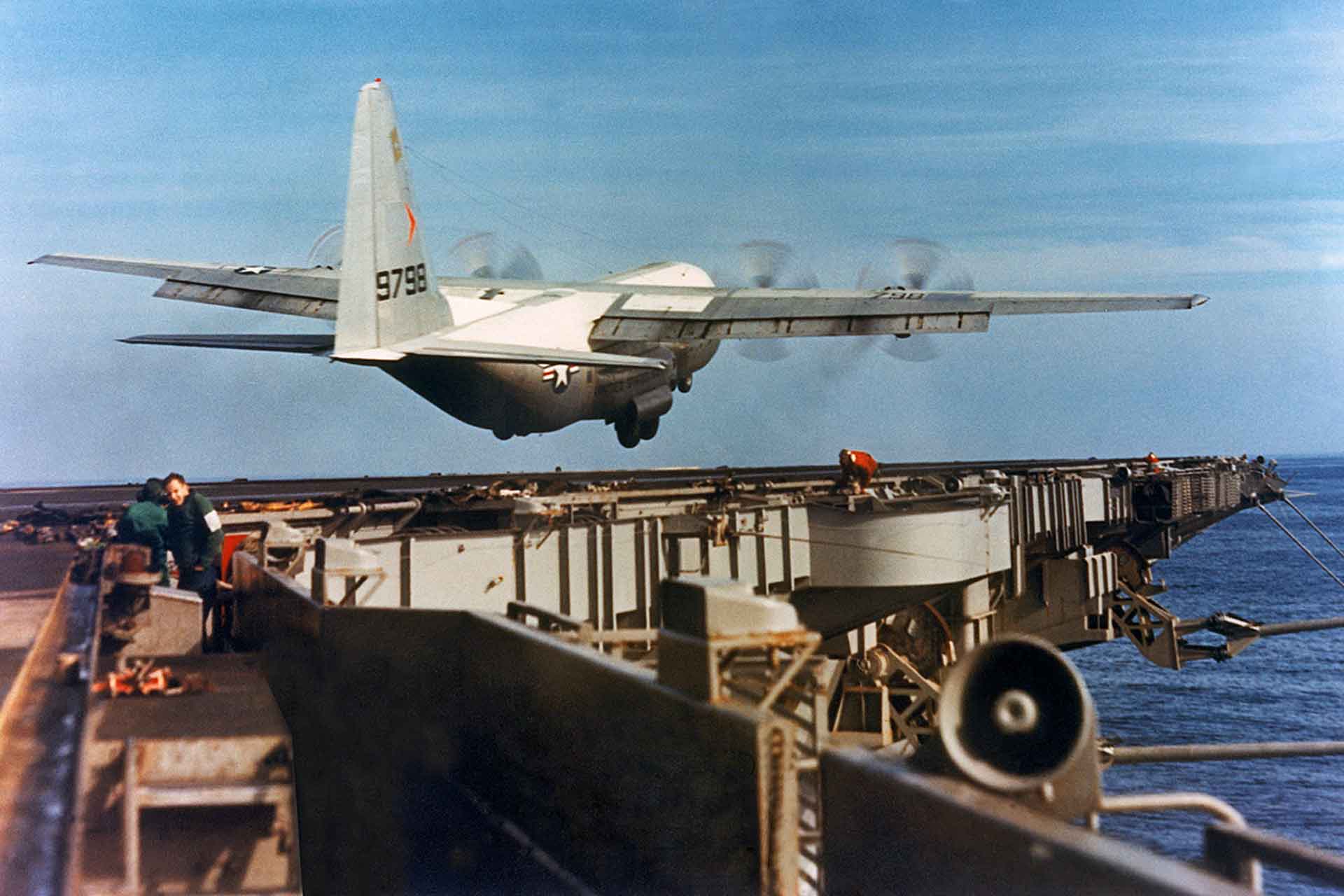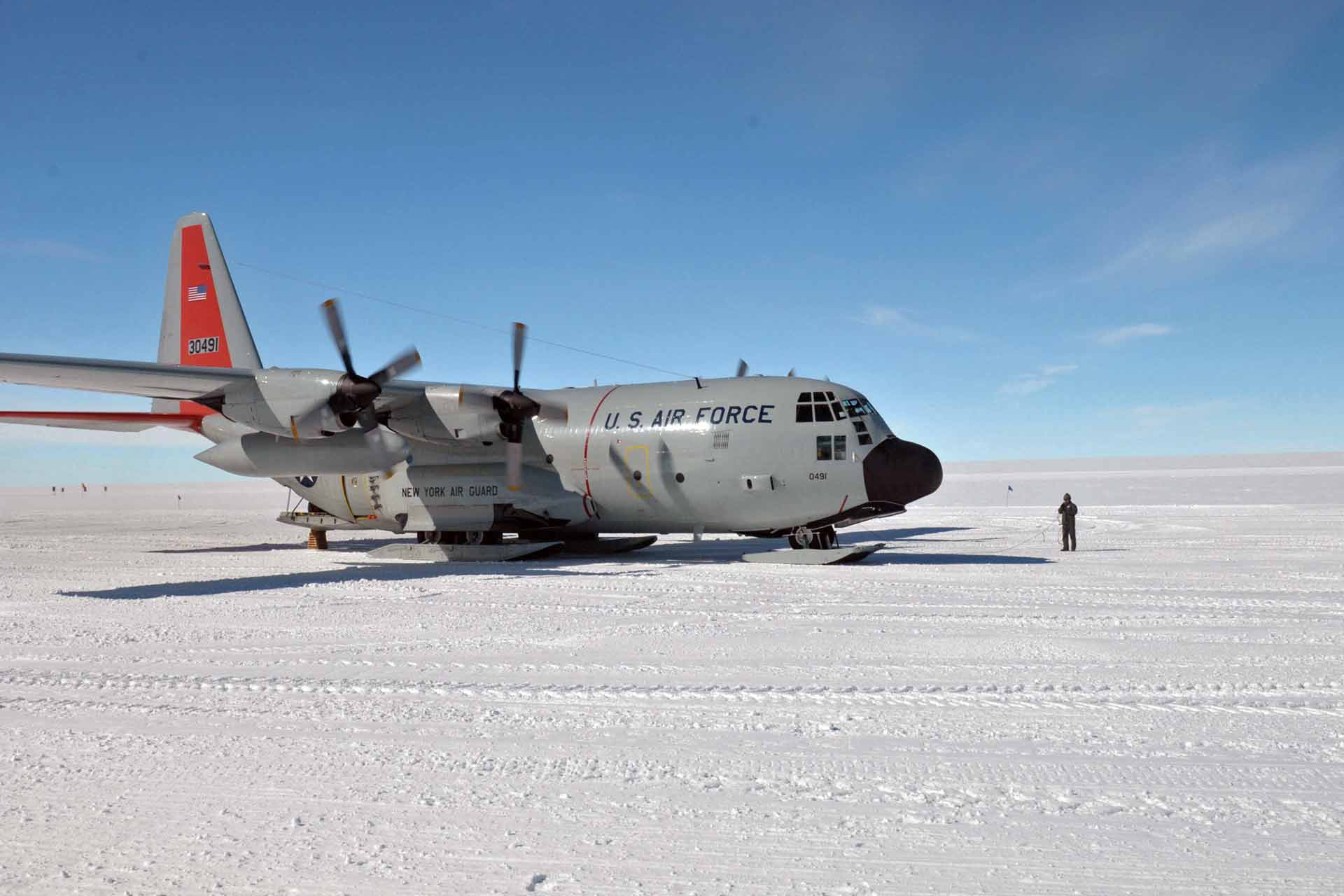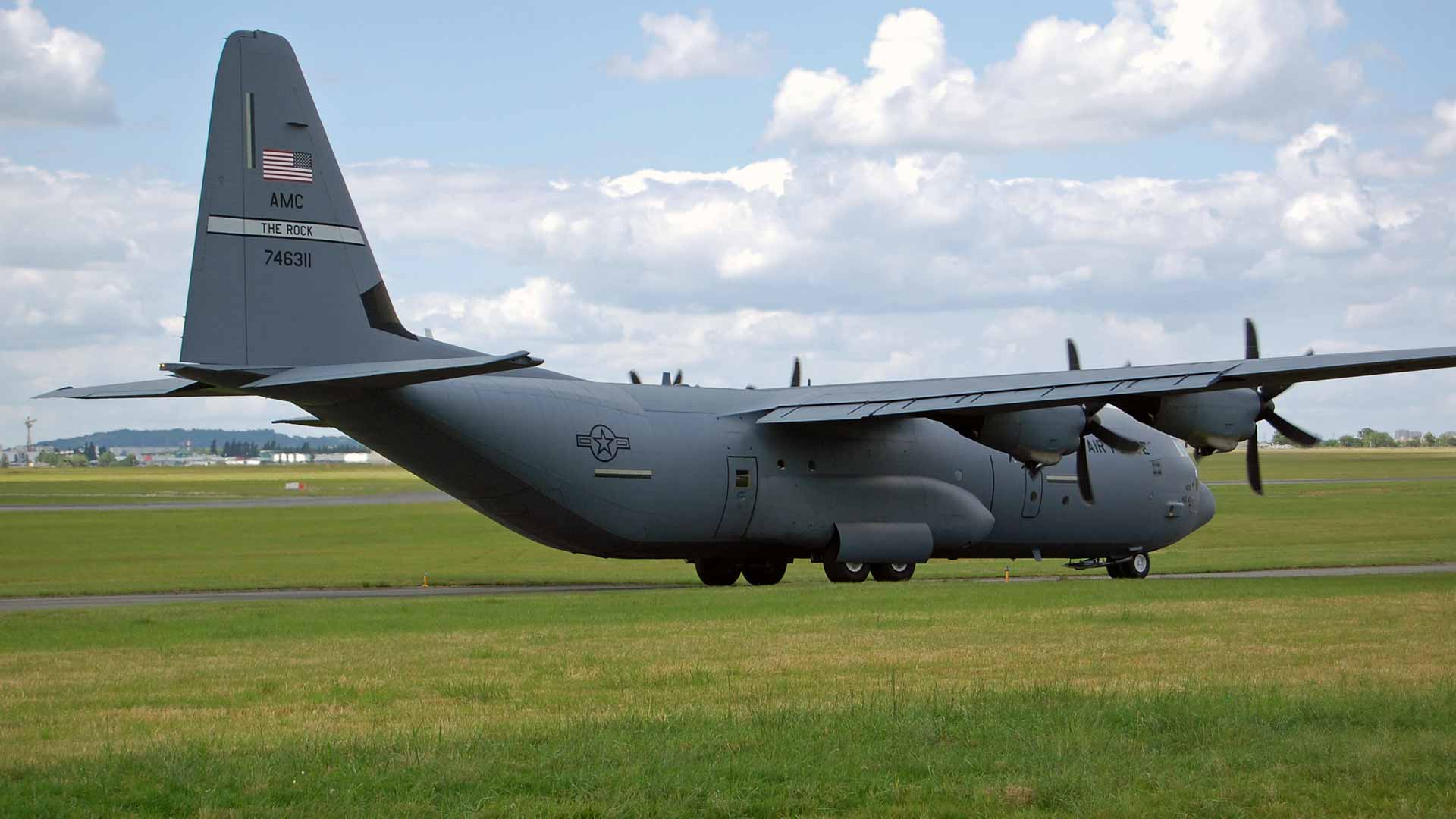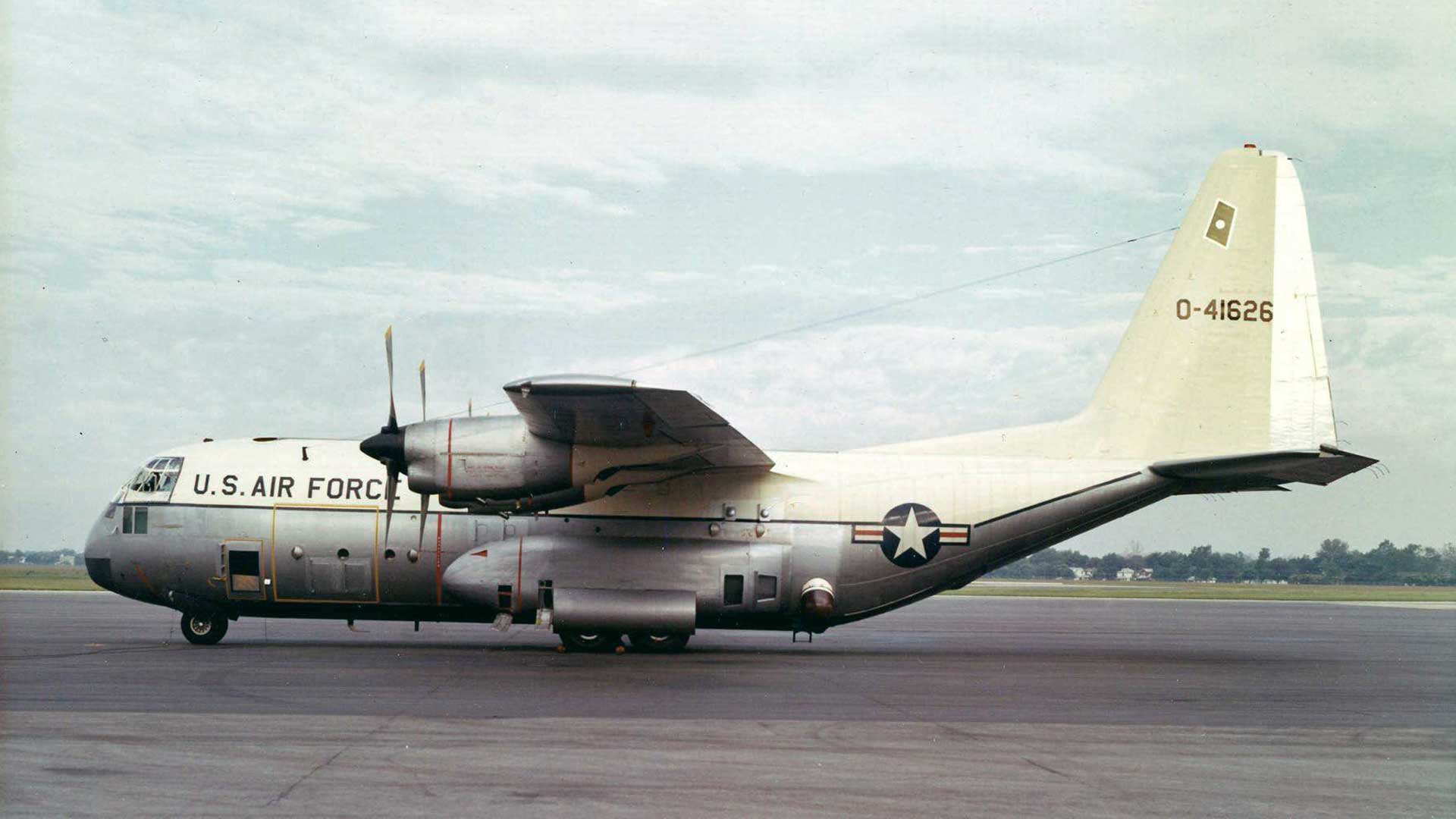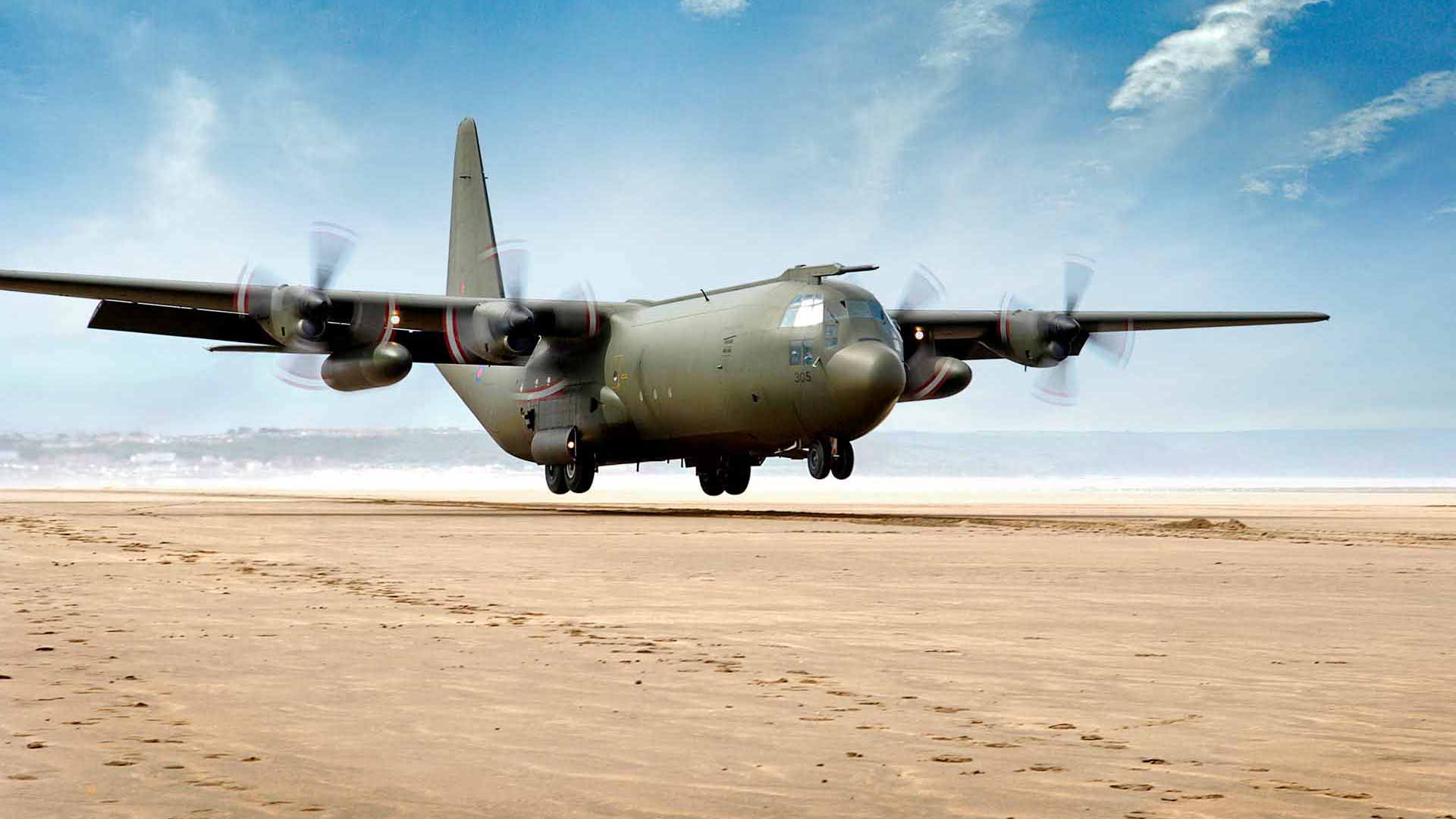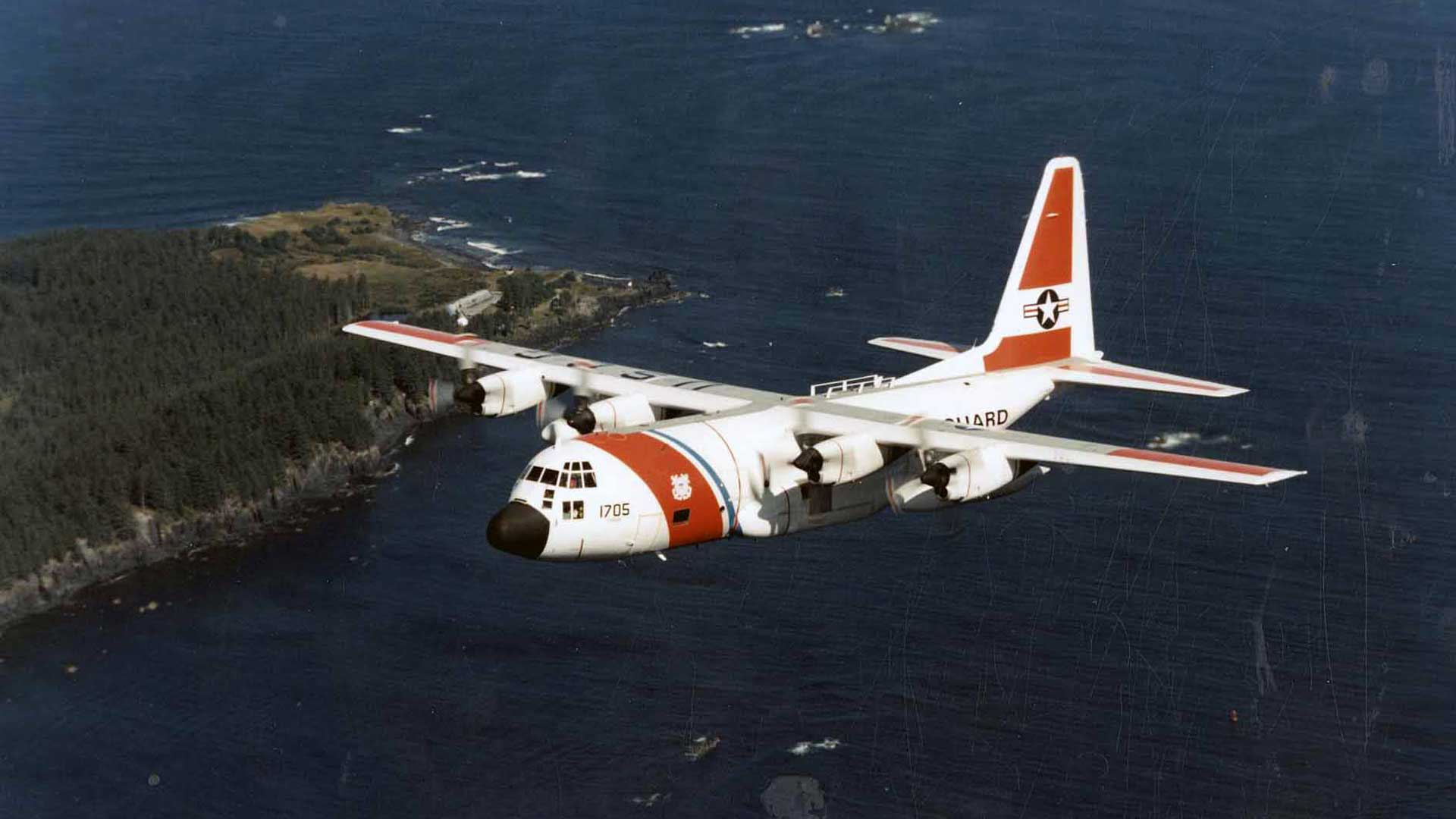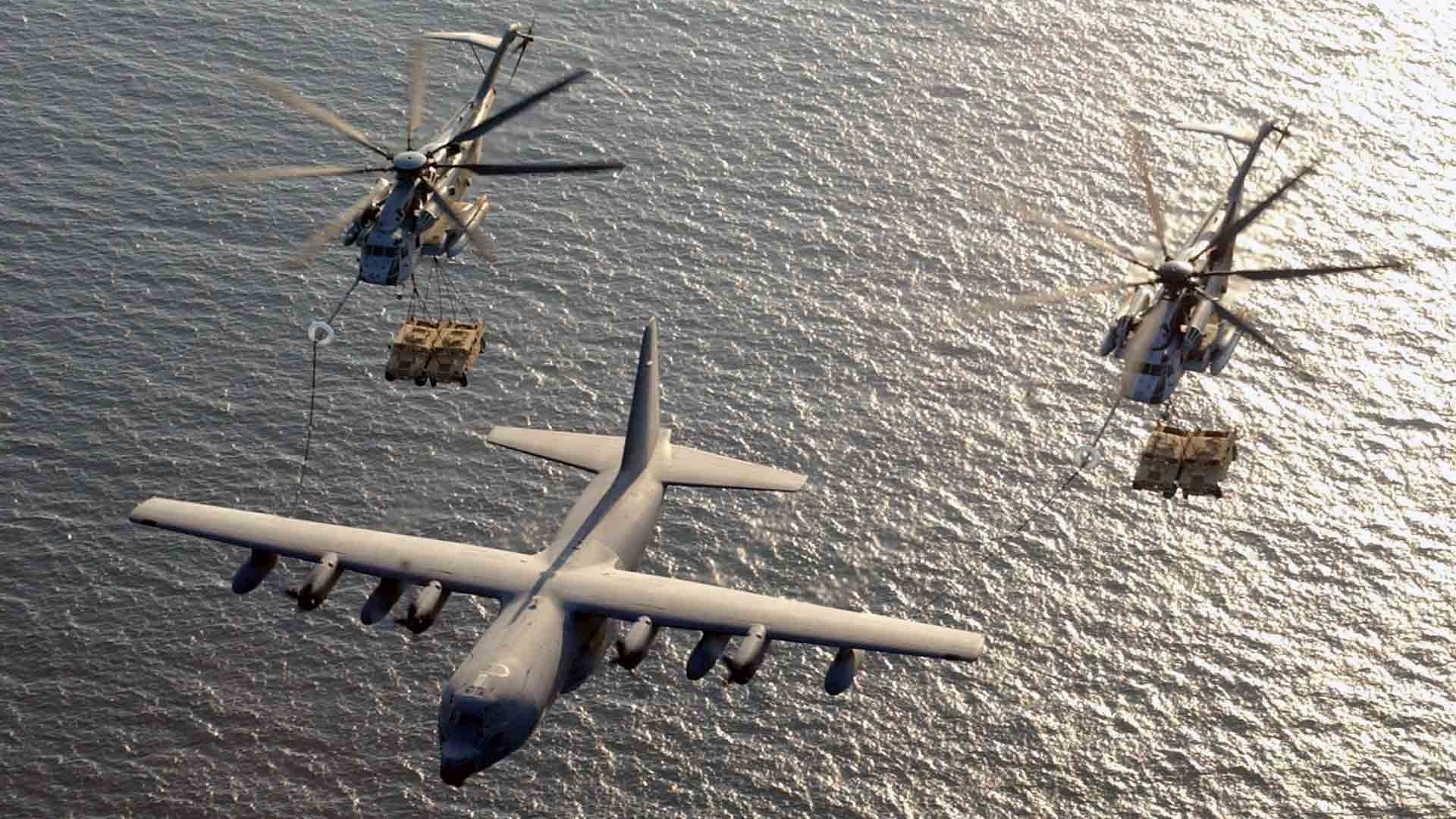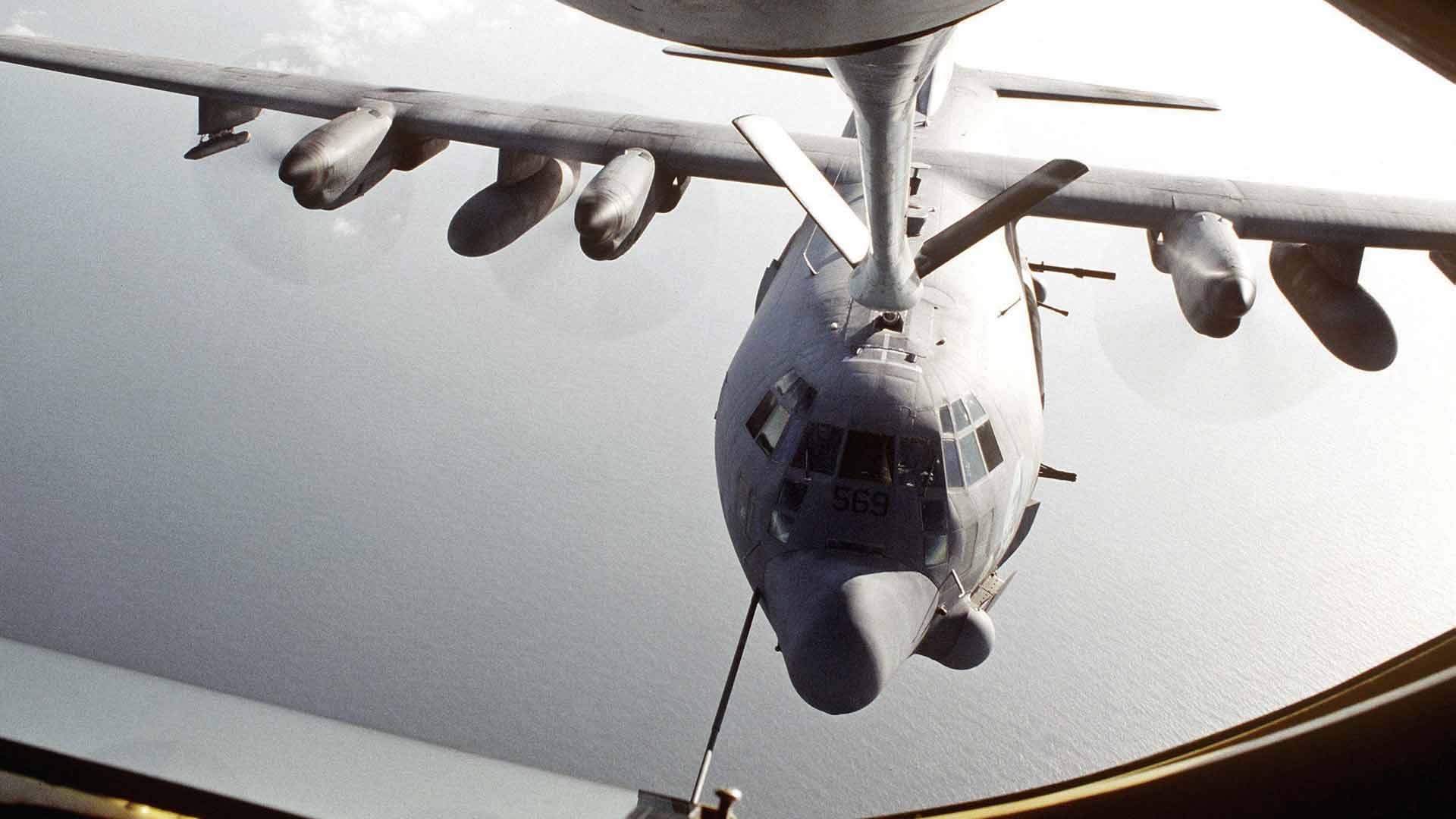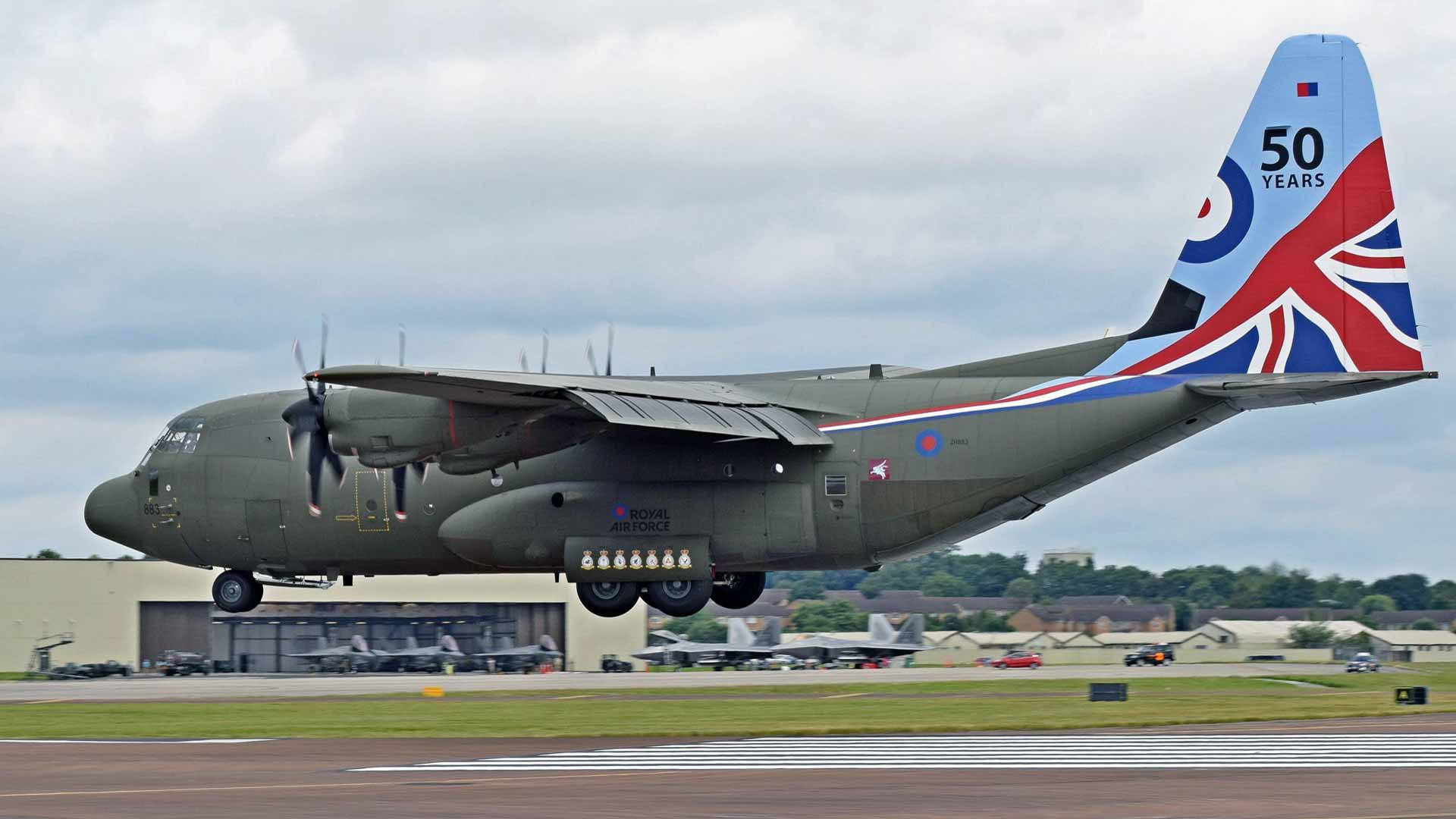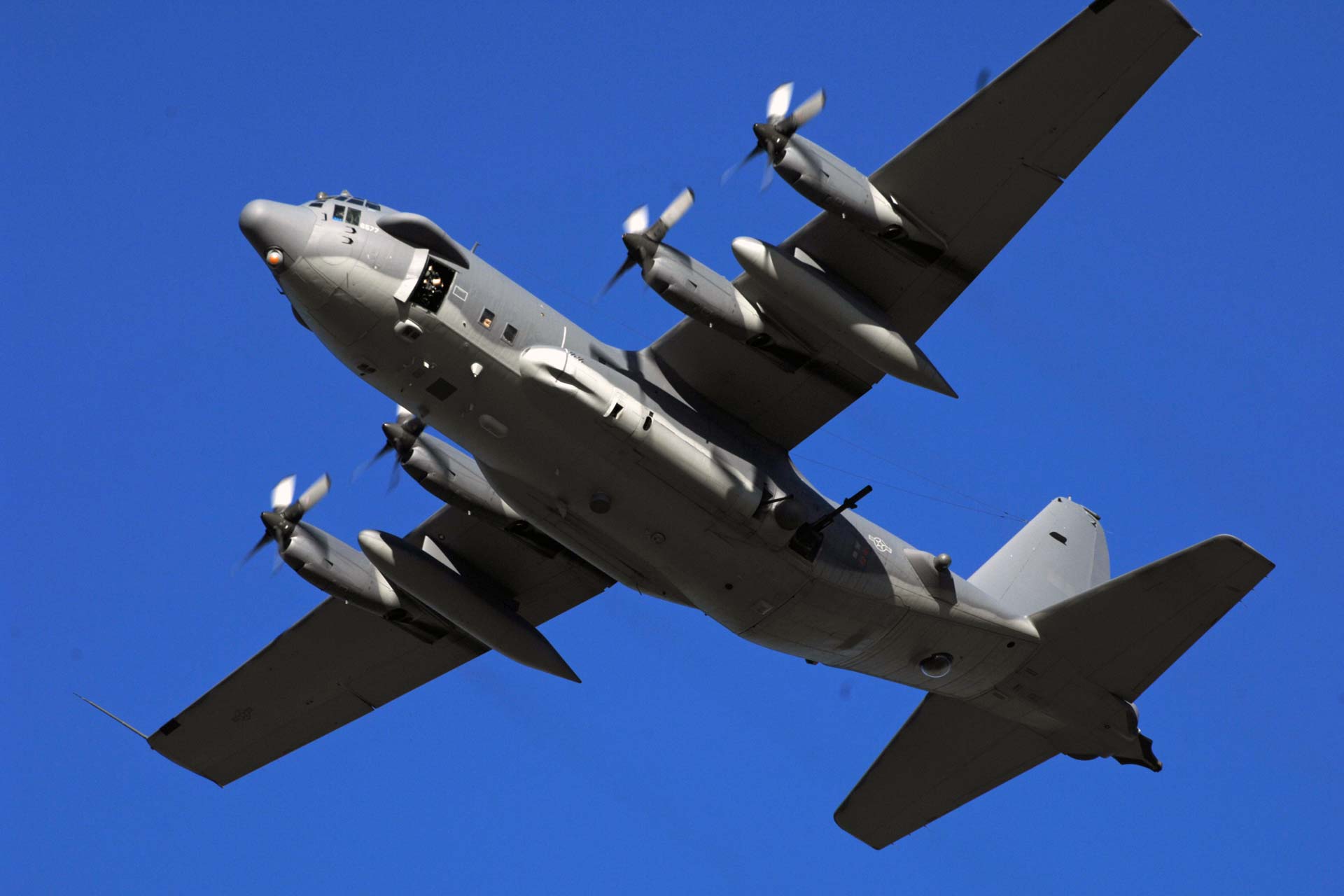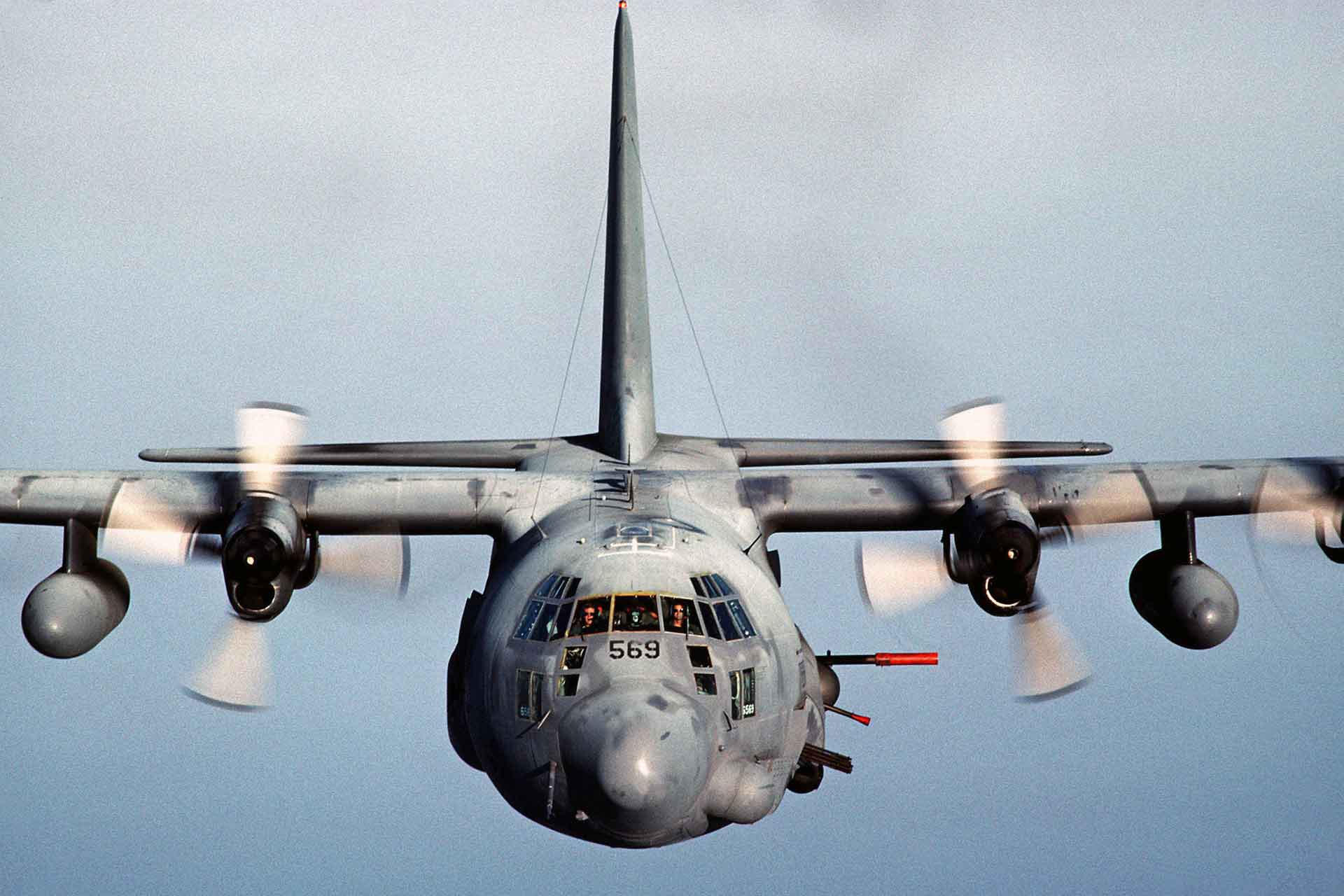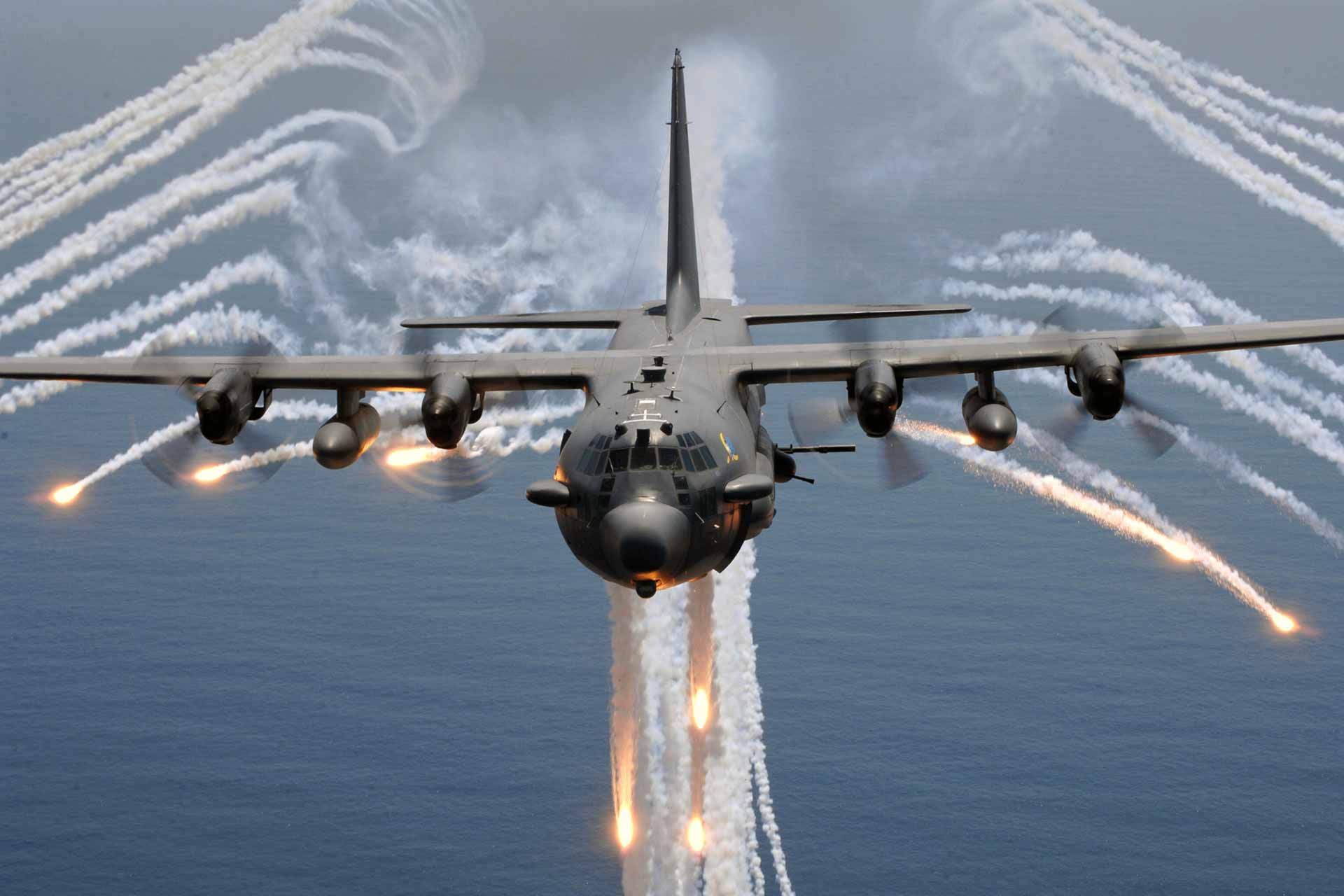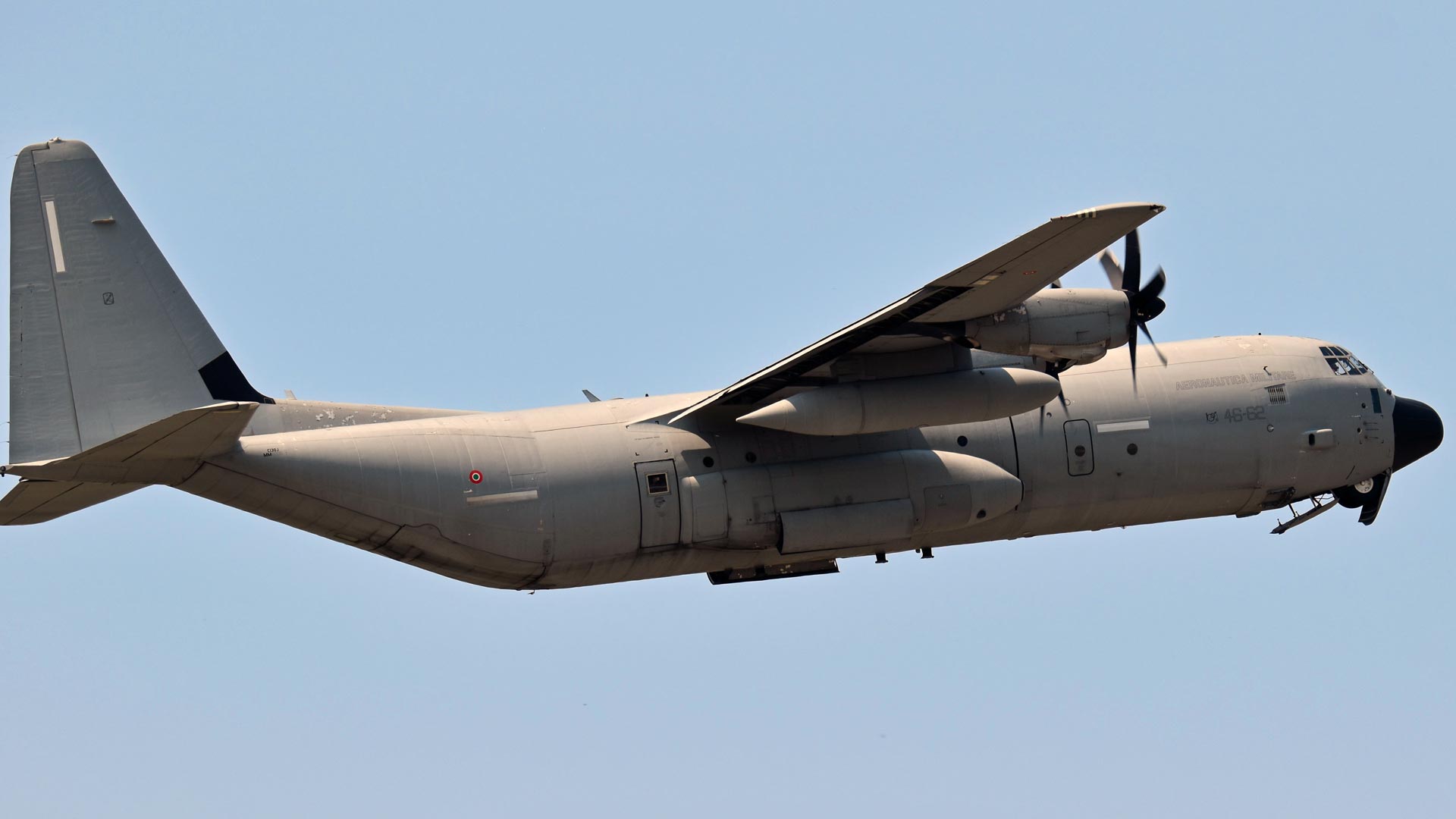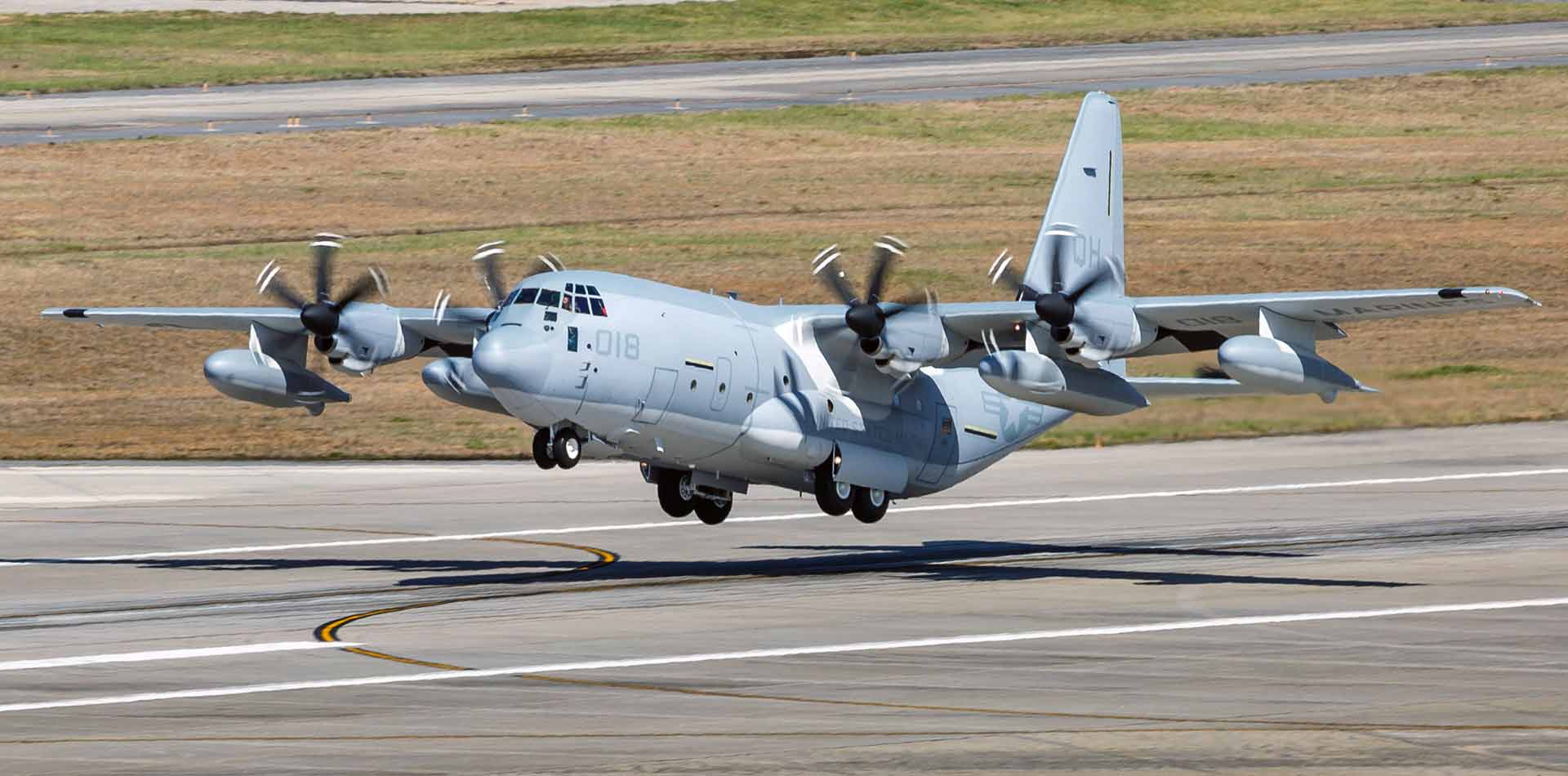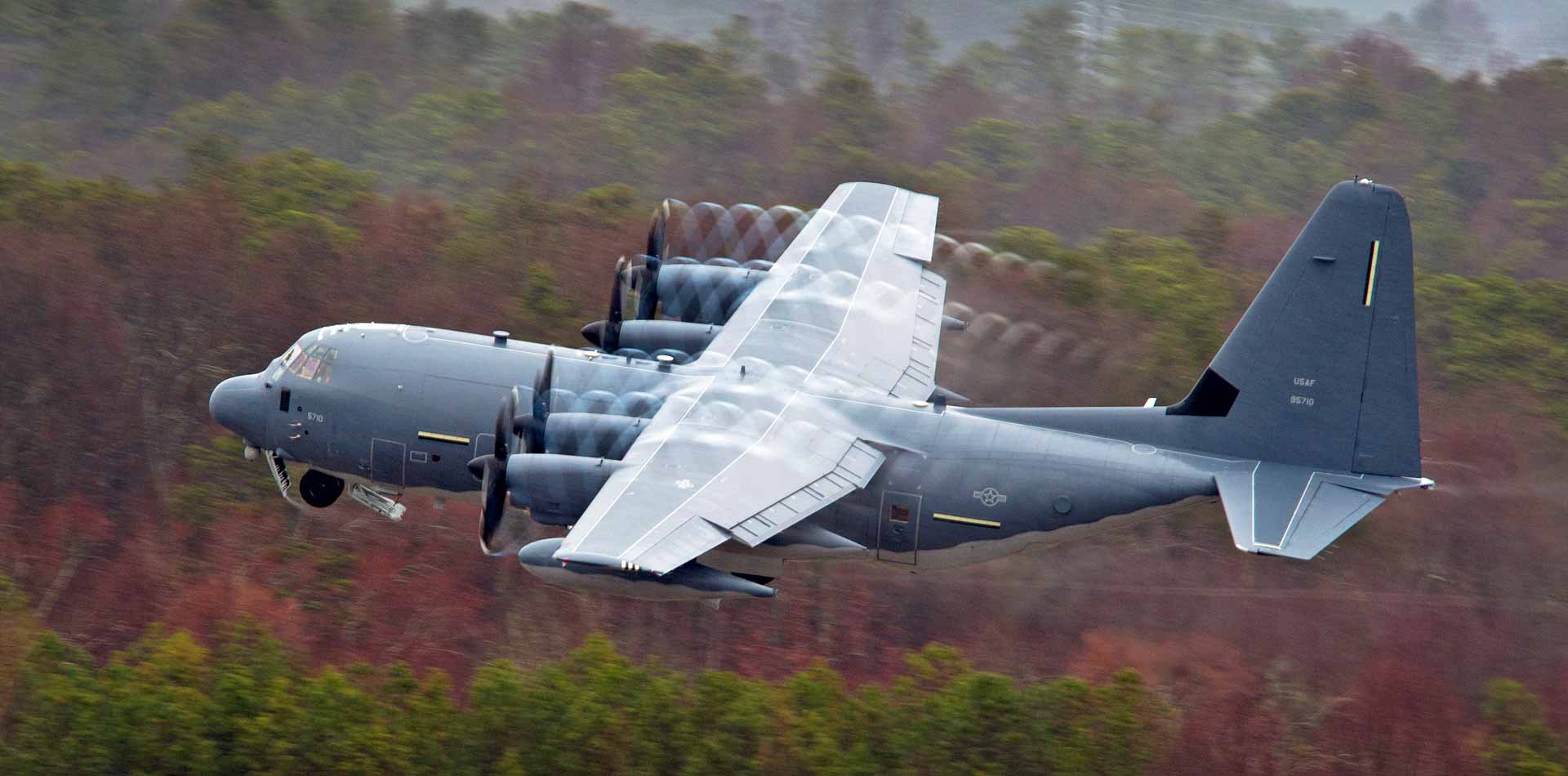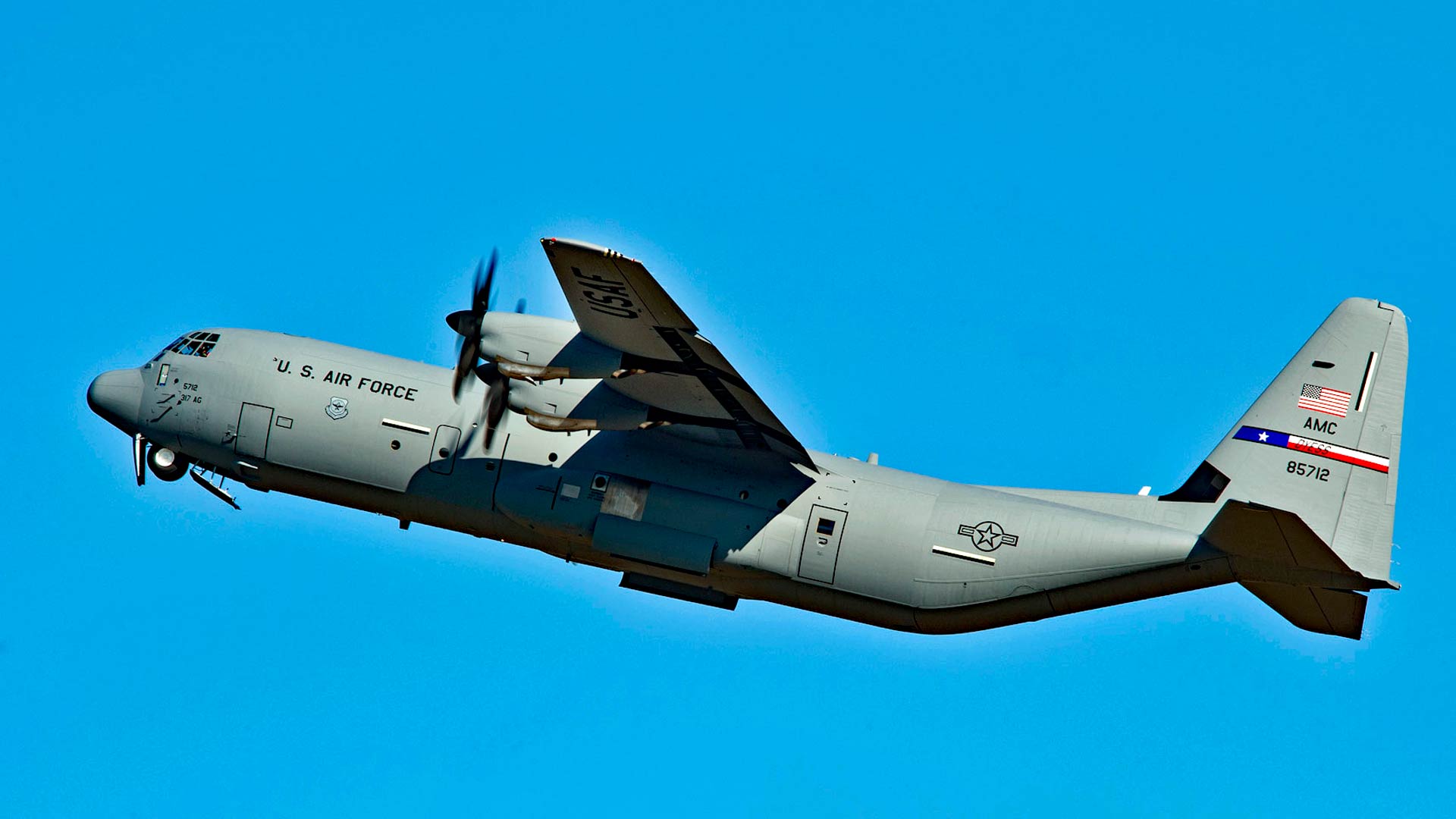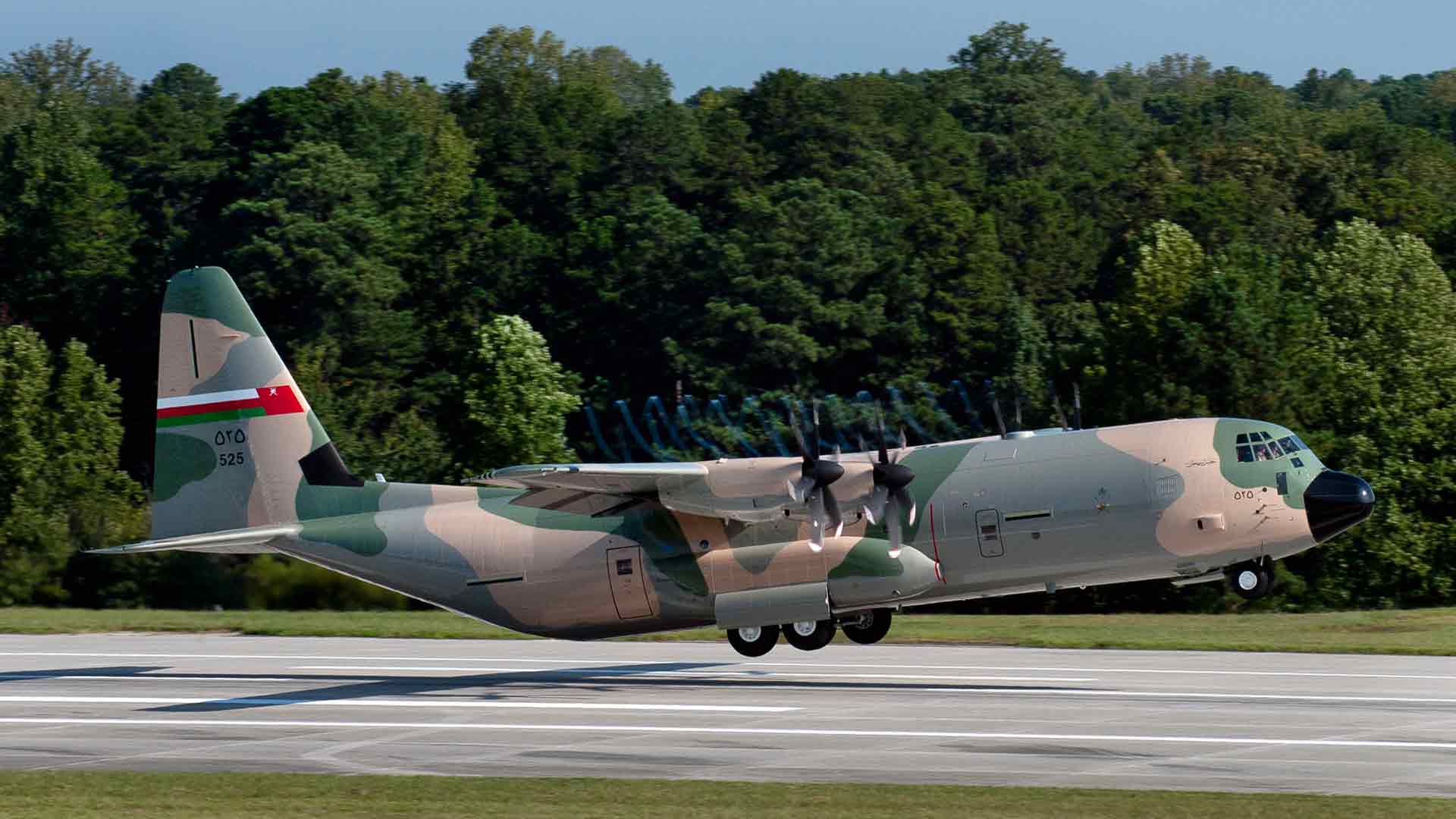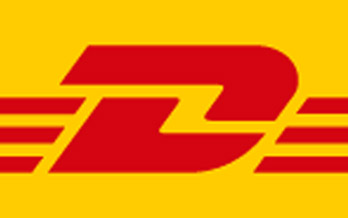The Airlift Legend turns 70
Amassing a good 2,500 units, the C-130 Hercules is one of the most successful and most produced transport aircraft since World War 2. Even 70 years after its first test flight, Lockheed's four-engine military transporter is still completing cargo flights without skipping a beat. Numerous sub-variants are also used for very specialized and often secret missions. The Hercules is truly unstoppable. We look back on a success story like no other.
For years, the U.S. Navy's "Blue Angels" aerobatic team used a C-130T called "Fat Albert" for transportation tasks, but also for show effects such as shortened take-offs with JATO auxiliary power units. In the meantime, supplies of these auxiliary launch rockets have run out, and the "Blue Angels" now use a modern C-130J. Photo US Navy
The Hercules, or simply "Herc", has become an integral part of aviation. A good 2,500 units built, serving with over 60 nations worldwide, are proof of the qualities of the military transporter. The legendary cargo aircraft was launched in February 1951 in response to a call for tender from the US Air Force. During the Korean War, the US Air Force realized that the piston-engine cargo planes from the Second World War were no longer fit for purpose. In their place, a medium-sized transport aircraft was required that could carry a payload of 13,608 kg or 90 paratroopers over a distance of 3,220 km. A rear loading ramp would also be able to drop off parachute troops and material at low-speeds. In addition, the transport aircraft had to be able to operate from unsealed runways or short take-off and landing airstrips. With this list of requirements, the nation’s big manufacturers Boeing, Douglas, Fairchild, and Lockheed were all asked to submit designs within two months. In April 1951, Lockheed Corporation finally won the race with its project proposal, initially called "L-206" and later "Model 82", and the Air Force provided Lockheed with the funds to build two prototypes.
This C-130H of the New Zealand Air Force carries large additional tanks under its wings. Photo: Bidgee
Convincing modern concept
With their new transport aircraft, the US Air Force wanted to introduce a modern type that could also be used in less favorable conditions worldwide, and that would surpass the performance of its predecessors. The main aim was to replace medium-sized transport aircraft such as the Douglas C-54 and Fairchild C-119, but in the longer term it was also intended to replace larger, equally outdated aircraft. The concept was based on a high-wing design that kept the engines high up, away from any blown-up sand and dirt. In keeping with the times, turboprops were chosen as powerplants, which promised both high levels of performance and economical operation. Four Allison T56 propeller turbines were proposed to power the aircraft. In 1949, the T56 completed its first testbench run, and was released just in time to be fitted to the Hercules. Meanwhile it has the distinction of being the longest-produced engine of its kind.
This photo illustrates very well what the aircraft and engines of a Hercules have to withstand in extreme situations. Photo: USAF / Brain Christiansen
Importantly, Lockheed incorporated a very spacious fuselage. With a circular cross-section on the outside, the interior cargo hold was almost square and measured 2.74 m in height, 3.05 m in width and 12.31 m in length. At the rear there were two loading gates with a hydraulically opening ramp. On the ground, it was intended as an access ramp for fast loading, whereas during flight, paratroopers, entire cargo pallets, and even smaller vehicles and light tanks could be dropped off by parachute. The cargo hold and cockpit were pressurized and the latter had extensive glazing with excellent visibility. In addition, there was robust landing gear for use on unsealed runways. In fact, take-offs and landings on sand or grass airstrips posed no problem for the aircraft. Indeed, even a ski undercarriage for snow-covered airstrips was an option, as was the attachment of additional propulsion units (JATO) to shorten the take-off distance. In line with innovations in design, Lockheed decided to use high-strength alloys and switch to modern manufacturing processes for the construction of the aircraft. And in the end, an in-house competition was organized at the manufacturing plant in Marietta, Georgia, which ultimately led to the byname "Hercules".
[1] To date, a KC-130F is the heaviest aircraft to have taken off and landed from an aircraft carrier, the USS "Forrestal". The trials to act as a heavy aircraft to supply the carrier fleet took place in November 1963. Photo: National Museum of Naval Aviation Pensacola
[2] Here an LC-130 of the New York Air National Guard demonstrates the use of ski landing gear on snow-covered ground in Greenland. Photo: USAF-ANG
Delivery begins late 1956
Two prototypes were ordered as YC-130s, and pilots Stan Beltz and Roy Wimmer began test flights on August 23, 1954. Indeed, testing on the C-130 produced results exceeding the project specifications, but of course not everything was yet fully developed. There were minor problems with the engines, for example, which could be solved by fitting a four-blade instead of the previous three-blade propeller. Allison also worked on increasing the performance of the turboprops. Finally, the first C-130A production aircraft flew on April 7, 1955, and deliveries of the first aircraft to the 463rd Air Transport Wing (Troop Carrier Wing) at Ardmore Air Force Base, Oklahoma, and to the 314th Air Transport Wing at Stewart AFB in Tennessee began in 1956.
A C-130J Hercules of US Air Force Air Mobility Command visiting Le Bourget, Paris. Photo: Heiko Thiesler
The early production models could be recognized by their blunt nose, which was later enlarged to accommodate a radar unit. Lockheed produced more than 200 aircraft of the first series version and handed over twelve of them to the first export customer, Australia, at the end of 1958. Even from the first series, derivatives were produced for electronic and aerial reconnaissance as well as for use as lead aircraft and drone carriers. They practically marked the beginning of the construction of countless special versions, whose real operational characters have been kept sometimes more and sometimes less top-secret. On the other hand, the use of the early production aircraft revealed a number of deficits that were to be remedied with the improved C-130B series.
[1] The prototypes and first C-130A production aircraft, including derivatives like this AC-130A Gunship, had a short fuselage and blunt nose. Photo: USAF
[2] In the service of the British Royal Air Force, the C-130K, based on the C-130H, flew in several versions until it was replaced by the C-130J. The air refueling boom above the cockpit is clearly visible. Photo: UK MOD
For longer range, this version was fitted with additional tanks under the wings as standard, and the propeller turbines were now fitted with the more efficient Hamilton four-blade propellers. For electronic reconnaissance tasks, 13 aircraft were converted to C-130B-II spec, others serving as SAR aircraft HC-130B with the US Coast Guard, and for weather reconnaissance as WC-130Bs. Last but not least, the first refueling aircraft were outfitted as KC-130Bs. A 14,000-liter tank housed in the fuselage and two hose reel tanks under the wings, each of which could dispense 1,100 liters per minute, were used to refuel other aircraft. This task has since been taken over by modernized versions of the Hercules, which can refuel large bombers, transport aircraft, supersonic fighter jets, and slow-flying helicopters equally well.
[1] The US Coast Guard was one of the early customers for the Hercules requiring a long-range aircraft available for patrol flights and SAR missions. It entered service in 1959. Photo: USGC
[2] Here, a KC-130 refuels two Sikorsky CH-53E heavy-lift helicopters. Photo: US DoD
[3] A gunship AC-130H is refueled in the air to extend flight endurance. Photo: US DoD
A true allrounder
In 1962, the C-130E entered service, having originally been developed as a transitional variant for long-haul flights. For this purpose, it was given increased fuel capacity both internally and externally, as well as more powerful T56-A-7 turboprops. In addition, upgrades were made to the aircraft's avionics and structure. The C-130E was also the starting point for a number of series for extraordinary missions. MC-130Es, for example, also known under the byname "Combat Talon", were often tasked with secret operations. Mostly in the dark of night, these aircraft infiltrated enemy airspace, deployed special forces and their equipment, conducted psychological warfare, and dropped leaflets or bombs on precisely localized targets. Like their successor models, they also had an extensive avionics system with various radar and navigation systems, infrared sensors, and warning receivers.
This C-130J aka Hercules C.5 of the Royal Air Force was presented in a special livery in 2016. The type has since been decommissioned in the UK. Photo: Adrian Pingstone
Then the AC-130E became the successor to the AC-130A gunship. The AC-130A had first flown in 1967, designed to provide close air support for troops on the ground, to keep the enemy away from exposed units, and to fight enemy formations by day and night. To this end, these aircraft were equipped with highly sensitive operational equipment consisting of searchlights, night vision cameras, infrared and laser sensors, radar equipment and detectors, plus heavy armament. These ranged from multi-barrel machine guns to cannons and howitzers, which gave them their "battleships of the air" name, but indeed they were used to devastating effect. All barreled weapons, up to the imposing 105 mm howitzer, are fired from the side of the aircraft. On these missions, the destruction of targets was often facilitated by flying in precise circles, although newer models now use precision weapons.
[1] Heavily armed and packed with sensors, the Hercules has long been used as a gunship. Here an AC-130H of a US Air Force special operations squadron. Photo: USAF
[2] This photo clearly shows the cannons of an AC-130 gunship mounted on one side. Photo: US DoD / Lee Shading
[3]To keep approaching surface-to-air missiles at bay, this AC-130H ejects a large number of decoys. They are hotter than the aircraft's infrared signature and redirect the missiles away from it. Photo: USAF
Progressing towards the current C-130J
The Hercules family tree grew steadily and Lockheed was always able to meet new requirements with modernized and redesigned variants. Deliveries of the third main series version, the C-130H, began in 1964, and aircraft entered service the following year. The C-130H mainly benefited from a revised wing, more efficient engines, and updated avionics. Series production of this variant continued into the 1990s and again included various special versions and a number of export customers. Users also included organizations and armed forces that were already familiar and satisfied with earlier Hercules models. After the almost 500 units of the E series, the C-130H and its derivatives, amounting to more than 1,200 units, became the most built version of the Hercules to date. It may one day be surpassed by the current production version, the C-130J, of which over 500 have now left the Lockheed Martin factory. Among these, the 2500th Hercules produced in December 2015 was in fact a C-130J.
The Italian Air Force has long been a Hercules customer. Depicted a modern C-130J-30 with its almost five meter longer fuselage. Photo: Heiko Thiesler
The C-130J, also known as the Super Hercules, made its maiden flight in spring 1996 and entered service two years later. It had been thoroughly overhauled by the manufacturer to meet the operating conditions of the early 21st century. The new Allison-Rolls-Royce AE 2100 turboprops with six-bladed propellers made of composite material were the first eye-catcher. They ensure improved economy, higher speed and longer range, as well as shorter take-off distances. For the crew, Lockheed designed a new glass cockpit with digital controls and displays, head-up displays, night-vision goggles and a mission computer. This made it possible to reduce the crew to two pilots, supplemented by a loadmaster. The crew has access to other modern systems including multi-purpose radar, GPS, navigation and communications equipment. As with the C-130H series, there is also a C-130J-30 variant with increased cargo capacity, stretched by almost five meters. Numerous special versions have been developed, such as a heavily-armed AC-130J gunship, the KC-130J tanker, the WC-130J weather reconnaissance aircraft, the HC-130J rescue and patrol aircraft, and the EC-130J and MC-130J for special operations.
[1] The latest tanker version is the KC-130J with the new AE 2100 turboprops and six-bladed propellers. Photo: USMC / Tinh D. Ngyen
[2] The wake of the six-blade propellers can be clearly seen on this MC-130J. Photo: Lockheed Martin
Plenty users, plenty missions
The Hercules boasts a huge number of users. The main customer for the tried-and-tested aircraft has of course been the US military, above all the US Air Force, including the National Guard and reserve units. Around 50 squadrons of this branch of the armed forces had or have the C-130 and its derivatives in their inventory. In addition, there are a number of NATO member states and other allies, including Third World countries. The Federal Republic of Germany is now also in the club. Together with France, a joint transport squadron based in Evreux-Fauville has been set up, which will consist of five C-130J-30s and five KC-130Js. Germany is providing the squadron with three each of these aircraft, with the first aircraft with the tactical identification 55+01 arriving in February 2022. By the 70th anniversary of the first flight of the Hercules, the squadron should be complete in order to fulfill the tasks of the decommissioned Transall and close the gap to the A400M. Civilian variants have also been produced and sold, with a total of 114 units by 1992. They were the L-100 and the L-100-20 with a 2.5 m longer fuselage. The L-100-30, on the other hand, corresponded to the C-130H-30 with a fuselage almost five meters longer. Recently, a derivative based on the C-130J, known as the LM-100J and intended for civilian cargo transport, has now also been certified.
This C-130J of the U.S. Air Force is retracting its landing gear. It has double wheels on all three assemblies. Photo: Lockheed Martin
Hercules have been involved in countless aid missions. They have completed numerous humanitarian missions, facilitating the support of and care for victims of natural disasters, they have rescued people in emergency situations, and helped to fight major forest fires. However, their history of military missions is truly enormous. Their first deployment in conflict situations took place in 1958 during the Lebanon crisis and in the Straits of Formosa, where tensions between China and Taiwan had just intensified. This was followed as early as 1960 by deployments in the Congo and, just a few years later, on a massive scale in South East Asia. The Vietnam War led to a much greater diversity of roles, as various special versions were used in addition to the transport aircraft. They carried out reconnaissance and rescue flights, launched and guided drones, dropped large numbers of soldiers as well as materials and technical equipment, provided close air support as gunships, and were part of other, often secret missions. There is no doubt that users will continue to rely on this legendary aircraft for years to come – and in all likelihood on new versions of the C-130 in the future. They too will become part of this aviation success story, the end of which is far from being written.
Oman is also one of the users of the C-130J series. They are part of the 16th squadron at the Al Musana airbase. Photo: Lockheed Martin
Text: Heiko Thiesler
Facts & Figures
Role: tactical airlifter
Crew: 3+
Engine: four Allison-Rolls-Royce AE 2100D3 with 3,458 kW each
Wing span: 132.57 ft
Wing area: 1.745 sq ft
Length: 97.9 ft
Height: 38.1 ft
Empty weight: 75,562 lb
Payload: 42,000 lb
Take-off weight max.: 70.307 kg / 155,000 lb
Cruising speed: 644 km/h / 400 mph
Service ceiling: 28,000 ft
Range: 2,100 mi
Users C-130J: Ägypten, Algerien, Australien, Bahrein, Bangladesch, Dänemark, Deutschland, Frankreich, Großbritannien, Indien, Indonesien, Irak, Israel, Italien, Kanada, Katar, Kuwait, Libyen, Neuseeland, Norwegen, Oman, Philippinen, Saudi-Arabien, Südkorea, Tunesien, USA

